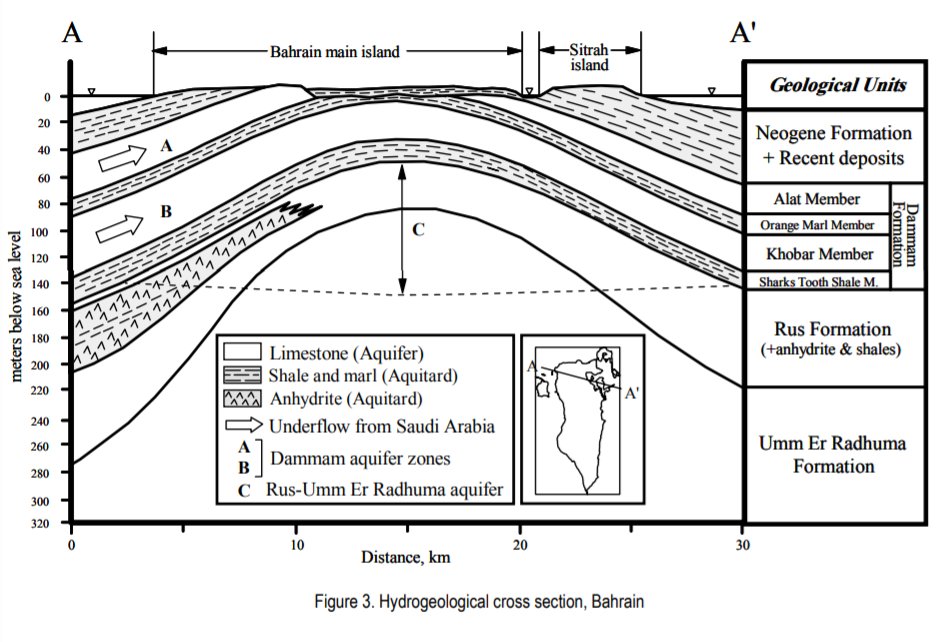Thread on the history of water in Bahrain/1
Bahrain& #39;s climate as we all known is characterized by high temperatures and scanty rainfall (71mm/yr). The high evapotranspiration rate (>1800mm/yr) means that Bahrain has no surface water, and groundwater is the only natural source of freshwater./2
Bahrain primarily depends on the Dammam aquifer (underground layer of water-bearing rock). This aquifer is a small part of the extensive regional system known as the Eastern Arabian Aquifer (extending all the way from Central Saudi to the Arabian Gulf). (Al Zubari, 1994)/3
Prior to 1925, freshwater was derived from 15 land and 24 offshore springs. These were locally known as "chawchab/kawkab", meaning "planet". Pearl divers would collect this "sweet water" in leather waterskins and sell it in the souqs. /4
Historically, the availability of freshwater was a critical factor for Bahrain& #39;s regional importance. Freshwater sea would perforate the adjacent landmass and sustained the thriving agriculture of the island. Culture and urban life in Bahrain was built on the presence of water/5
Springs would feed irrigation channels, and the location of palm trees indicated the presence of springs and channels that distributed water. Watering and distribution was governed by customary laws passed down through oral tradition until some were written./6
A deed from 1587:
"To water the land it should be from sunrise to noon on Sunday. And on Tuesday from sunrise to noon. And on Friday from noon until the light starts coming out from the East"./7
"To water the land it should be from sunrise to noon on Sunday. And on Tuesday from sunrise to noon. And on Friday from noon until the light starts coming out from the East"./7
In 1925, the first artesian wells in Bahrain were drilled. Groundwater abstraction would become the sole source for meeting water demand until 1975. Unfortunately, poor drilling techniques, increasing demand, and over-exploitation led to contamination and saltwater intrusion./8
Land reclamation has also contributed to increased salinity and has been implicated in destroying underground channels that fed local springs. Groundwater abstraction eventually exceed the aquifer safe-yield (the recharge rate of the aquifer) [Al Zubari, 2005] /9
Bahrain has since turned to primarily non-conventional water sources consisting of desalination plants and the use of treated wastewater. Bahrain currently has 6 desalination and 11 wastewater treatment plants. As a result, Bahrain has been able to meet rising water demand/10
However, this has come with significant costs that are expected to increase to meet demanda of a rapidly growing population and urbanization rates. Between 2013 to 2020, the expected cost amounts to 11 billion USD and consume 15.9 billion cubic meters of gas/11 (Al Zubari 2014)
In addition, 78 million tonnes of CO2 would be emitted. Desalination plants pose a major environmental risk, where brine discharge, untreated wastewater due to excess hydraulic loads, and sludge destroy the already declining coastal and marine life/12
Climate change is going to have a devastating impact. Increased water demand due to rising temperatures. seawater intrusion to groundwater sources due to rising sea levels, and less groundwater recharge due to decreased rainfall, and many other things./13
Bahrain has one of the lowest per capita freshwater availability in the world, and is considered one of the world’s most water-stressed countries. Per capita water availability stands at 70 cubic meters/year, well below the acute water poverty line of 500./14
Significant revenues from oil have made it possible to keep up with increasing demands despite growing water scarcity. Without significant change and regional cooperation, a water crisis is inevitable in the near future./15

 Read on Twitter
Read on Twitter
![Land reclamation has also contributed to increased salinity and has been implicated in destroying underground channels that fed local springs. Groundwater abstraction eventually exceed the aquifer safe-yield (the recharge rate of the aquifer) [Al Zubari, 2005] /9 Land reclamation has also contributed to increased salinity and has been implicated in destroying underground channels that fed local springs. Groundwater abstraction eventually exceed the aquifer safe-yield (the recharge rate of the aquifer) [Al Zubari, 2005] /9](https://pbs.twimg.com/media/Ea1SWVZXgAIzBYp.png)


